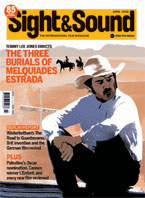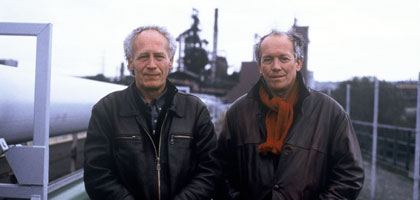
Interview

Jonathan Romney talks to Luc and Jean-Pierre Dardenne
Jonathan Romney: In 'Le Fils' you pushed your style to the limit, with Alain Marcoen's camera hanging close to Olivier Gourmet throughout. In 'L'Enfant' you hold back again - the style is closer to 'La Promesse'.
Luc Dardenne: We had two characters this time, so we were framing wider. It was more a question of getting the actors to move around in and out of the frame than of moving the camera. Here we're not showing things either from Sonia's or from Bruno's viewpoint - it wasn't like seeing through Rosetta's or Olivier's eyes.
We actually tried going wider still but it didn't work - we ended up feeling that we were composing images. We try to avoid that at all costs: the sense that everything becomes readable and you can say, 'Oh yes, this element refers to that, there's this diagonal...' Do that and you end up losing the fluidity, the energy, the tension.
'L'Enfant' is very much a film about absences. Bruno is absent at the start, and later when he goes to the flat, we never see who collects the baby.
Jean-Pierre Dardenne: We thought it would be better for the viewer if we stayed with Bruno, except once when we see the person he's dealing with. If the traffickers stay out of sight, it creates more tension and allows the viewer to travel with Bruno in real time. When I saw the film again at Cannes I found myself thinking, 'Why doesn't he go and get the baby before the others come to take him? He can still change his mind.' Keeping the others outside creates a greater empathy for Bruno.
Some critics were surprised to find that after the first few minutes it turned out to be Bruno's story rather than Sonia's. She more or less disappears once she kicks him out.
LD: We liked the idea of starting the film with her for ten minutes then suddenly jumping to Bruno. We wanted people to feel the absence of the person she's looking for.
Then once she kicks him out he has to find his own way of getting back to her so that she can also come back to him. He has to experience something on his own.
JPD: Although the film is partly a love story between Bruno and Sonia, what interested us is the way that Bruno ends up changing. We could have focused on Sonia
- how she goes about trying to change him and bring him back
- but that would be another film, not the one we decided to make.
Do you always know the endings of your films in advance?
LD: We always know the ending in advance, but sometimes it changes while we work.
JPD: We'd written two or three endings for Le Fils.
LD: We had one in the script, but it felt too written...
JPD: But two or three in our minds.
Your films have endings that give meaning to lives which otherwise might seem completely contingent. Many people see them as stories of redemption, and in the case of 'Le Fils' people felt it must be about Christ.
LD: Everyone brings their own ideas to a film. A Christian viewer might be happy to see that, while a non-Christian might say, 'What a shame, they've made a Christian film.' But the film is what it is, and there are several possible interpretations, I hope. For us the ending of Le Fils isn't about forgiveness because the boy never asks for forgiveness - Olivier simply doesn't kill him, that's all. And so perhaps life can begin again. We never wanted to express any thesis, Christian or otherwise - it's simply a human story: you harm someone and you try to repent. But our civilisation is so much founded on religion that it's hard to get away from it.
I'd say our films are about guilt, but not about sacrifice in a Christian sense. We never sacrifice our characters - nor do we sacrifice anyone else so that they can find salvation, as religion would require. Our characters are alone, and their sense of guilt makes them even more alone - until finally they find a connection with another human being. Without a doubt, what we're most preoccupied with is the idea that guilt allows people to change.
It imprisons people, but then they take stock of what they've done.
Realism in your films has a certain physical weight - the timber in 'Le Fils', the water in 'L'Enfant'. We know it's real river water - that it's cold, dirty, that it drags on the actors' bodies.
JPD: That's what we're after with the actors too. We feel Bruno's weight, Sonia's weight - we want them to be really present, like the water. It's what allows the actors to vibrate on screen.
How do you decide on your characters' look? For instance, Bruno's hat makes his personality very concrete.
JPD: Before we started shooting we spent a lot of time with Jérémie and Déborah in the locations. Sometimes the sets weren't ready or we didn't know where we would put the furniture, but spending an hour and a half there helped us and them - it's like absorbing the place gently, like a sponge.
Also, every evening for a month we'd go to the costume department and try out different clothes. No costumes are specified in the script - we see what the costume designer comes up with, try out different things, try not to let Bruno and Sonia get stuck in stereotypes. Often the actors get attached to particular clothes, they think, 'Ah, this is the jacket...', and use it as a protective shield. We've realised that whenever an actor gets attached to a certain thing you have to go against it.
But the hat was in the script. We started shooting with the hat, then when our producer Denis Freyd saw the rushes he said, 'Look, this isn't what you said you were after, this character's completely caught up in a stereotype.' He was right, but by then it was too late: we'd started shooting, and we always shoot chronologically. So we had to find a way of losing the hat - and that's why he sells it in a bar.
After 'La Promesse' Jérémie Renier became a fairly well-known face, working with François Ozon and Bertrand Bonello. Was it hard for him to get back into your way of working?
LD: A lot of directors don't work that much with actors - François Ozon is an exception. So actors tend to fall back on their own technique. We absolutely wanted Jérémie for the film, but we were worried that he'd come with that technique actors pick up after ten films.
But he was delighted, because he was able to leave that technique behind and work alongside people who'd never acted before. You can tell the camera loves those people - their faces, their almost innocent presence. It was a challenge for him to match their level. And he also agreed to be a child, like in La Promesse. That's why we wanted him to have blonde hair, though at first he wanted to go dark to be different from Igor in La Promesse. And then he decided that Bruno's surname - Michaux - would be the same as Igor's.
Bruno could be Igor in a parallel life.
JPD: And perhaps Roger - the Olivier Gourmet character - is recycled too. He's become a cop.
You've made five fiction films in Seraing. Have you exhausted its possibilities yet?
LD: Whenever we think up characters we always see them in Seraing. We'll have to see.
You've talked about the importance of locations. Does a lot of location scouting go into the writing itself?
JPD: It's very important. We often write 'Exterior. Street' and we know more or less where it's going to be, but once we've been out scouting it can always change.
We spend a lot of time at the locations because that's where the story starts to come to life.
And we both spend a lot of time going around with a video camera - we look for the apartments ourselves, call people up, we really enjoy that. We'll do that for three or four months.
Did you research the theme of child traffic?
LD: Not really. We knew it existed, how it worked. It needed to be plausible, but we didn't research it.
In an earlier version of the script, when they came to get the child, you saw them. And we realised that if we did that the film would head in a different direction. Once Bruno had seen them they'd have to kill him, so he and Sonia would have to run away - and we weren't interested in that.
It's an extraordinary moment. Bruno is waiting in the flat for them to take the baby, but we never see what happens in the next room.
JPD: Especially since we've seen him take off his jacket and put the child on it. So it's really happening - it's right there, behind a thin wall. So as not to lose the tension we filmed it in one shot, so you really get a sense of how long Bruno has to wait. When you go for long takes it's all or nothing - and that's fun.
LD: What's also fun is sometimes you find yourself doing things for purely practical reasons. Bruno comes in, he takes a look around, comes back, puts the child down, goes into the next room and looks out of the window. Now, if he'd closed the door, which he does in the script, the crew wouldn't have been able to follow him. So we had him take a call on his mobile: someone asks, 'Have you closed the door?' and he goes and closes it - and so the crew were able to follow him into the room. That way we didn't have to cut.
It must be difficult to overcome the viewer's immediate tendency to get sentimental over babies, though here you manage to place us at a distance.
JPD: It's important for people to know that it's a living creature, but we didn't want to give it a personality.
LD: It was important to see it at the start. After that, it's a packet that changes hands, that's all. It has to stay an object - that was the principle we decided on from the start. When I saw the film again in Cannes I was very relieved when Bruno goes back to the garage looking for it and he finds it and comes out with it. It was amazing. I didn't realise it would feel like that.
After winning your first Palme d'Or with 'Rosetta' did you worry about what you'd do next? Some directors would think that either they had to do something entirely different, or do exactly the same again.
JPD: It was less complicated for us than for someone who had already made ten films. As for what we'll make after L'Enfant, we'll have to see. It's hard for us to know whether we're doing the same thing or not.
LD: We have to feel that same need to start again each time...
JPD: ...and not feel as if we're just going to the factory. Because then you might as well go and work in a factory.
LD: The thing is to find a new challenge - like working with Sharon Stone, for example... [Laughs]
JPD: That's his dream. I'd love to see Sharon Stone working in a joiner's shop in Seraing.
LD: That's what I mean - getting her to learn soldering. It's not easy: it takes a lot of rehearsal, a lot of hard work.
